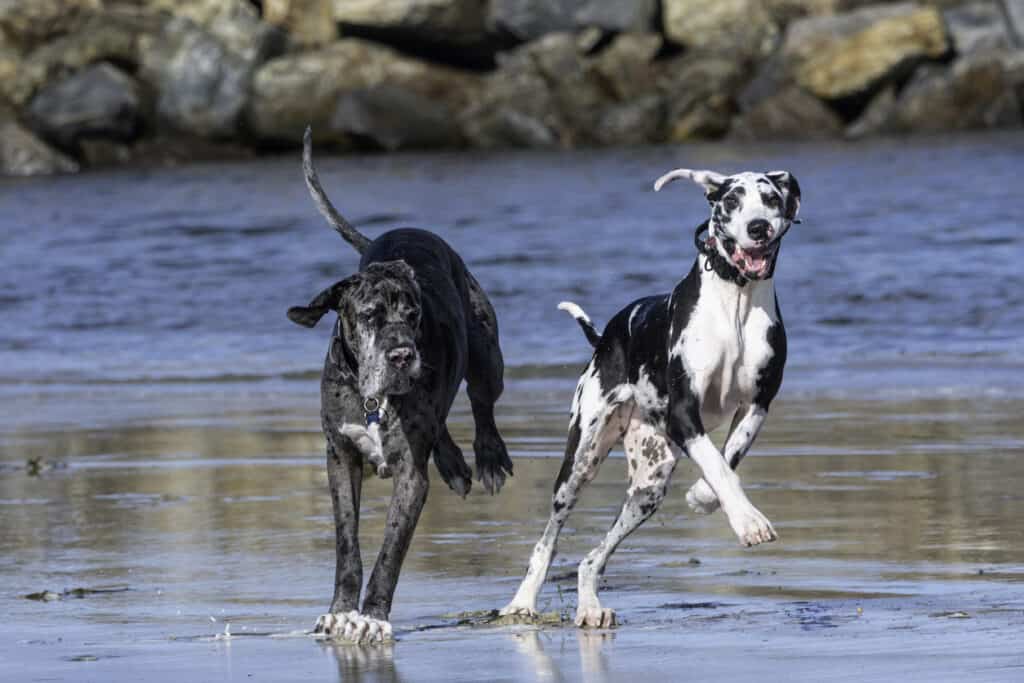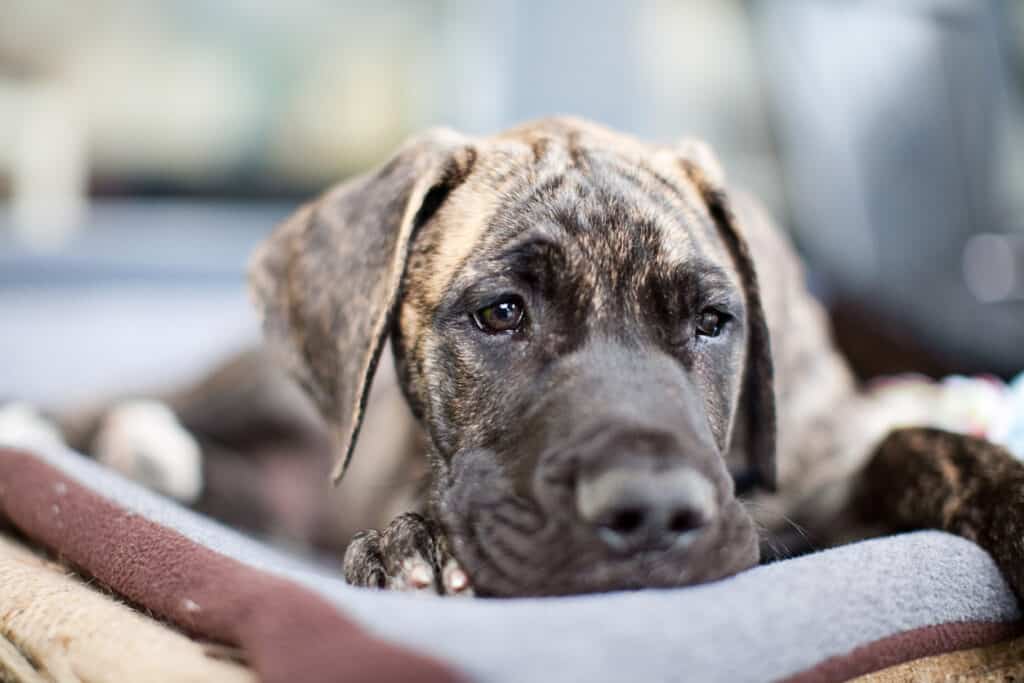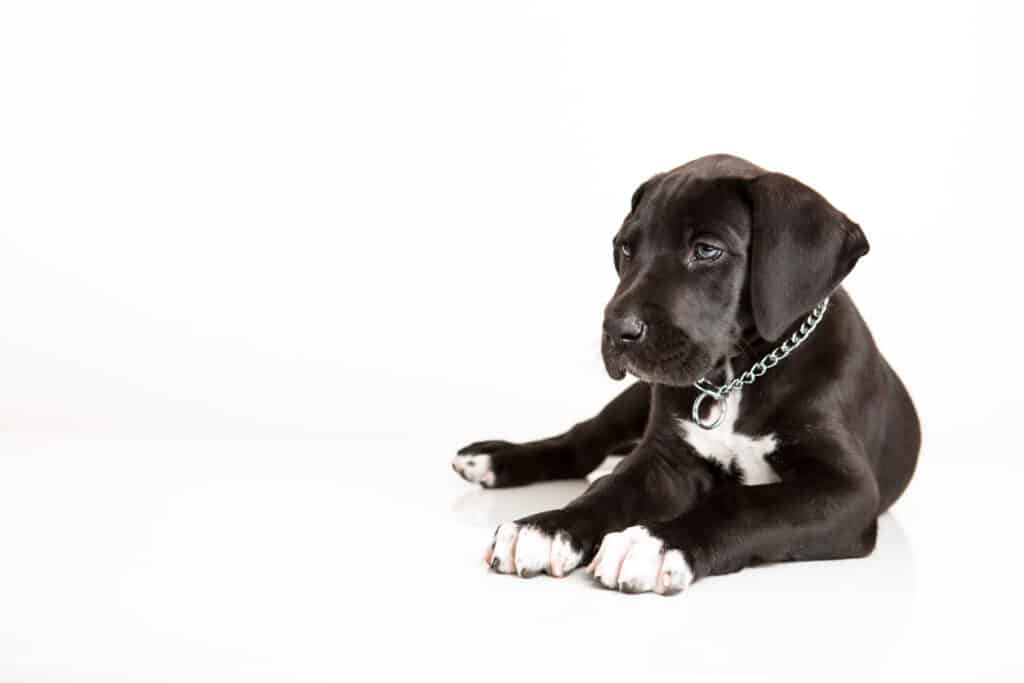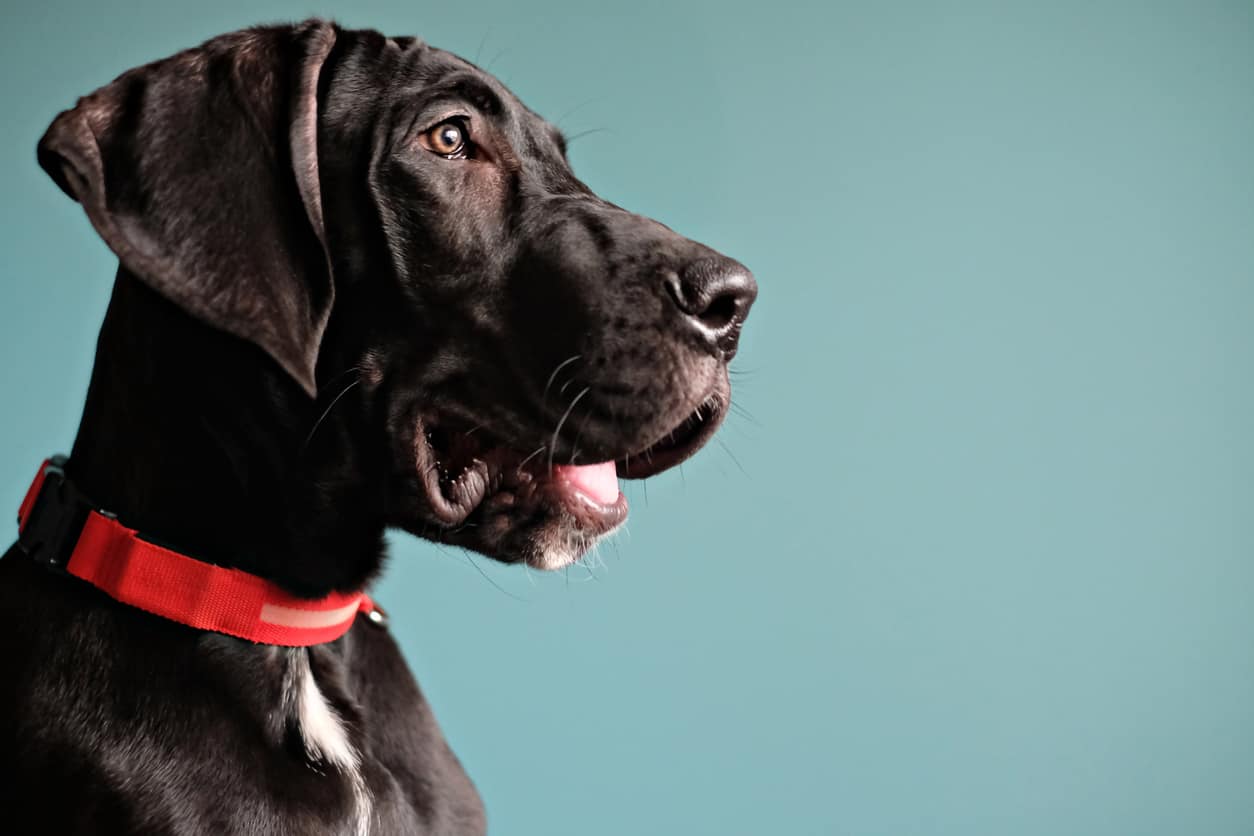Great Danes are one of the largest dog breeds on earth, sharing the “tallest breed” spotlight with Irish Wolfhounds. With male Danes topping out at heights of nearly 36 inches at the shoulder and females around 30 inches, they make striking and elegant companions alongside their owners and are the 16th most popular dog breed in the United States.

Great Danes are well known as docile and affectionate animals. Historically used to catch wild boar in the forests of Germany, the Great Dane is technically a German Mastiff. In Germany, they are called “Deutsche Dogges.”
After being used for generations as a hunting dog, Great Danes took on a security role for nobles, and today are known as dogs that make both excellent family pets and guard dogs. Their genetics likely include a mix of English Mastiff and Irish Wolfhound, which accounts for their massive size and height.
In 2021, the World’s Tallest Dog, a Great Dane named Freddy residing in Leigh-on-Sea in Essex with his Owner Claire, passed away at the age of eight and half years old. While eight and a half years may not seem like many years, it does fall within the standard lifespan of a Great Dane, which is 7-10 years.
For his part, Freddy held the record for tallest living male dog for five years, earning the accolade in 2016. During his official measurement by the Guinness World Records’ Editor-in-Chief Craig Glenday, Freddy stood 40 inches (101.6 cm) tall at the shoulder. Although not used as an official metric by the GWR, when he rose onto his hind legs, Freddy stood a towering 7’5 ½ (226 cm). Incredibly, Freddy’s owner reported that he was the runt of the litter when she first brought him home!
While Freddy was undeniably a huge Great Dane, he did not in fact hold the record for the tallest dog ever. That honor went to Zeus, a male Great Dane who lived in Otsego, Michigan and measured 44 inches (111.76 cm) at the shoulder. Zeus passed away at the age of five in September 2014.
Even though Freddy and Zeus became such massive Great Danes, they didn’t start out that way! Like all dogs, Freddy and Zeus were once puppies who went through all the usual stages of growth that dogs do. Of course, in the case of Great Danes, this growth can be pretty explosive.
Great Danes grow in stages
As a puppy

The most explosive growth happens when a Great Dane is a puppy. On average, you can expect your large-pawed baby Dane to pack on 15 to 20 pounds every month from two to six months of age. Typically, a Great Dane’s major growth spurt begins somewhere between 4-6 months of age, but every individual dog is different. As long as your veterinarian gives your Great Dane a clean bill of health, the rate of growth shouldn’t be a problem unless you plan to show your Great Dane. In that case, the American Kennel Club has certain standards that the breed is expected to adhere to, including meeting milestone height and weight expectations.
Signs of an impending growth spurt include symptoms consistent with the body changes your pup is experiencing. For example, a Great Dane puppy may experience frequent hiccup episodes as its chest deepens and elongates by the week. They may whimper seemingly without reason and withdraw from physical touch as a result of their growing pains. While in most cases these are simply indications that a puppy is growing, it’s always a good idea to check in with your veterinarian if you have any concerns about the puppy’s health.

It goes without saying that Great Danes eat a lot, but owning a Great Dane puppy may leave you feel as though you’re truly being eaten out of house and home. This is an expensive breed to own, and one of the chief expenses is feed. A Great Dane puppy between 3-6 months will need anywhere from 4-8 cups of food per day, which is about 2,500-3,000 calories’ worth, and all that food must be broken into 3-4 smaller meals. Female Great Danes tend to eat slightly less than males, but if you’ve got a tall girl on your hands, she’ll likely need those extra cups.
As your Great Dane puppy grows, all that weight is fueling an enormous growth spurt that is putting enormous pressure on their skeletal frame, which will also result in the need for lots of naps. When your Great Dane puppy is sleeping, younger family members should be taught to leave them undisturbed.
Imagine growing two feet (24 inches) and putting on around 100 pounds in your first year of life! For reference, human babies grow a maximum of one inch each month from the time they’re born until their six-month birthday, and between 6-12 months their growth actually slows slightly. By their first birthday, human babies are about the same height as a Great Dane if you stand them up, but they weigh 80% less.
As your puppy is growing, it’s common for them to look a bit gangly and bony. Their bones and hips may become quite visible, even if you’re practicing correct Great Dane feeding practices and providing several smaller meals a day or high-quality food designed for large and giant breeds.
A little-known but important fact about Great Danes is that they should not be jogged as puppies. Despite their size seeming to be appropriate for going on leashed runs, the high-impact nature of the activity is detrimental to their bone and joint health. Thus, a Great Dane puppy should not be jogged until around 18 months of age, at which point the activity may be introduced gradually and with care.
Puppies are rarely aware of their limits or what is best for their overall health, so it’s up to owners to be vigilant and take care that their furry family members do not overexert themselves. Prior to jogging, it’s essential that Great Dane puppies learn how to properly walk on a leash. Great Dane puppies also require anywhere between 1-2 hours of exercise per day depending on their disposition and energy level, meaning there will be plenty of opportunities to raise a well-mannered jogging companion when they’re ready.
As an adolescent
During this stage of growth, Great Danes are especially susceptible to developing Wobbler’s syndrome.
Wobbler’s syndrome is a disease of the neck that commonly occurs in large and giant dog breeds. The disease is caused when the spinal cord and spinal nerve roots become compressed, resulting in neck pain, problems with the nervous system, and an unnatural wobbling gait, from which the syndrome derives its name.
While half of all cases of Wobbler’s syndrome are claimed by the Doberman Pinscher, Great Danes are one of the other breeds at major risk for developing this disease. If your Great Dane develops this condition, it will possibly require an expensive corrective chance, and it will definitely require medical treatment throughout the rest of its life.
The most important factor in controlling the pressure placed on your young Great Dane’s skeletal frame is its speed of growth. Great Danes should be fed on a schedule and with quality food that promotes a slow and steady rate of growth. Doing so will give the skeletal frame, bones, and joints time to strengthen naturally and fully.
Like all adolescents, Great Danes can be naughty. During this phase of growth, owners should take care to diligently and patiently reinforce the obedience lessons they would like their Danes to learn. This also provides your big baby with mental stimulation, an important factor in their development. This is a large breed that is not always aware of how its size may impact its surroundings (for example, their tails are known to clean coffee tables or knock unsuspecting toddlers onto the ground), so every opportunity to teach your Great Dane how to be a responsive and calm dog should be taken with care.
Adult Great Danes
Great Danes are typically fully grown around two years of age, but it can take until close to three before they’re fully filled out. An adult Great Dane that has been properly nourished and raised should be muscular but with a slim silhouette. Danes are easily recognizable with their deep chest and pronounced tapering at the waist. Their ribs and hipbones should not be clearly visible but should contribute to the overall svelte look of the animal.
Owners will likely notice that their adult Great Danes become quite mellow in temperament. They are often content to nap the day away and have even been described as lazy, but it’s important to ensure that your tall pet receives at least 30-60 minutes of appropriate exercise each day. Despite their size, Great Danes are not made for high-impact exercise like intense long-distance running or challenging hikes. Their height actually makes it hazardous to their health to push them to perform high-impact exercises – their bones and joints can be easily injured.
The taller your Great Dane, the more mindful you need to be of how you exercise them. Whenever possible, seek out soft surfaces for walking or gentle jogging, such as trails or dog parks. Dog parks also offer the added benefit of socialization, which is crucial for Great Danes because they can become skittish and shy if not regularly socialized with other humans and animals. Some dog parks may also have lakes, in which you can encourage your Great Dane to swim. Swimming is an excellent exercise option for Great Danes because it is zero impact and builds strength.
Another exercise component to bear in mind with such a tall animal is strength training. Practicing “sit,” climbing and descending stairs, and even safely training your dog to rise up onto its hind legs by teaching “stand” on command are all ways to build your Great Dane’s strength and contribute to its overall longevity. Not to mention, the latter makes an excellent party trick!
In conclusion, Great Danes make wonderful pets, but do require their owners to be vigilant about providing the appropriate care during their prolonged growth phase. One of the many reasons that owners love this breed is because of its size and indeed there are two types of Great Danes available to lovers of this breed.
American Great Danes are slightly slimmer than European Great Danes, which tend to have just a slightly blockier overall look. Their jowls and lips tend to be looser, which produces more drool, although it should be noted that this is a drooly breed at baseline. European Great Danes typically weigh more than their American counterparts, but are not necessarily much taller, meaning that their lifespan may fall on the shorter end of the spectrum.

